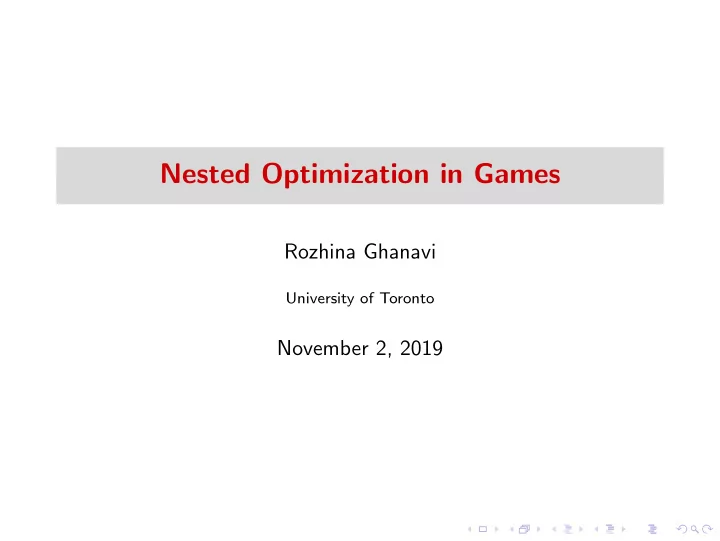

Nested Optimization in Games Rozhina Ghanavi University of Toronto November 2, 2019
Different types of games • Simultaneous games • Sequential games, Stackelberg games: consists of a leader and a follower, the follower observes the leader’s quantity choice and choose action based on that. � � min f 1 ( x 1 , x 2 ) | x 2 ∈ arg min y ∈ X 2 f 2 ( x 1 , y ) (1) x 1 ∈ X 1
Motivations • Why we are interested in games? Use cases in ML: GANs, adverserial training, and primal-dual RL. • What is the problem? Simple gradient based methods are not working and we are looking for other optimization methods.
GANs from Binglin, Shashan, and Bhargav.
GANs min G max D V ( G , D ) (2) � � V ( G , D ) = p data ( x ) log( D ( x )) dx + p z ( z ) log(1 − D ( g ( z ))) dz z x (3) • Equilibrium no longer consist of a single loss, hence nested optimization.
GAN optimization algorithm • GAN optimization is based on gradient descent ascent (GDA). • Update the discriminator by ascending gradient: m 1 � � x ( i ) � � � � z ( i ) ���� � ∇ θ d log D + log 1 − D G (4) m i =1 • Update the generator by descending gradient: m 1 � � � z ( i ) ��� � ∇ θ g log 1 − D (5) G m i =1
Convergence of Learning Dynamics in Stackelberg Games T. Fiez, B. Chasnov, and L. J. Ratliff
Games setting • They considered a sequential Stackelberg game (pure strategy: Stackelberg equilibrium). • This game consists of a leader and a follower.
Finite-Time High-Probability Guarantees The follower converges to: P ( � x 2 , n − z n � ≤ ε, ∀ n ≥ ¯ n | x 2 , n 0 , z n 0 ∈ B q 0 ) → 1 (6) where, z k = r ( x 1 , k ) and r ( x ) is the implicit function.
Finite-Time High-Probability Guarantees The leader converges to: � ≤ ε, ∀ n ≥ ¯ �� � ˆ �� � x 1 , n − x 1 n | x n 0 , x n 0 ∈ B q 0 ) → 1 (7) P t n Take away point, we converge to a neighborhood of a Stackelberg equilibrium in finite-time, with a good probability!!
Conclusions • Shows that there exist stable attractors of simultaneous gradient play that are Stackelberg equilibria and not Nash equilibria.
Conclusions • Shows that there exist stable attractors of simultaneous gradient play that are Stackelberg equilibria and not Nash equilibria. • A finite-time high probability bound for local convergence to a neighborhood of a stable Stackelberg equilibrium in general-sum games.
On Solving Minimax Optimization Locally: A Follow-the-Ridge Approach Under blind review at ICLR 2020
Games Setting • Differentiable sequential games, • Two players, • zero-sum, minimax, x ∈ R n max min y ∈ R m f ( x , y ) (8)
How to solve minimax optimization? • Gradient descent-ascent (GDA) • Problem 1. The goal is to converge to local minimax points, but GDA fails. Problem 2. Strong rotation around fixed points. Requires small learning rate. • Follow-the-Ridge (FR), proposed by this paper. • Solves both issues.
Follow the ridge (FR) • GDA tends to drift away from the ridge. • How to solve it? By definition, a local minimax has to lie on a ridge. So, follow the ridge!
FR algorithm
FR algorithm
FR results from the paper.
Conclusion • It addresses the rotational behaviour of gradient dynamics and allows larger learning rate than GDA.
Conclusion • It addresses the rotational behaviour of gradient dynamics and allows larger learning rate than GDA. • Standard acceleration techniques can be added.
Conclusion • It addresses the rotational behaviour of gradient dynamics and allows larger learning rate than GDA. • Standard acceleration techniques can be added. • In general we were so hyped about using GD in neural networks because we knew they are converging, this method can be viewed as a similar way to think about GANs
Recommend
More recommend